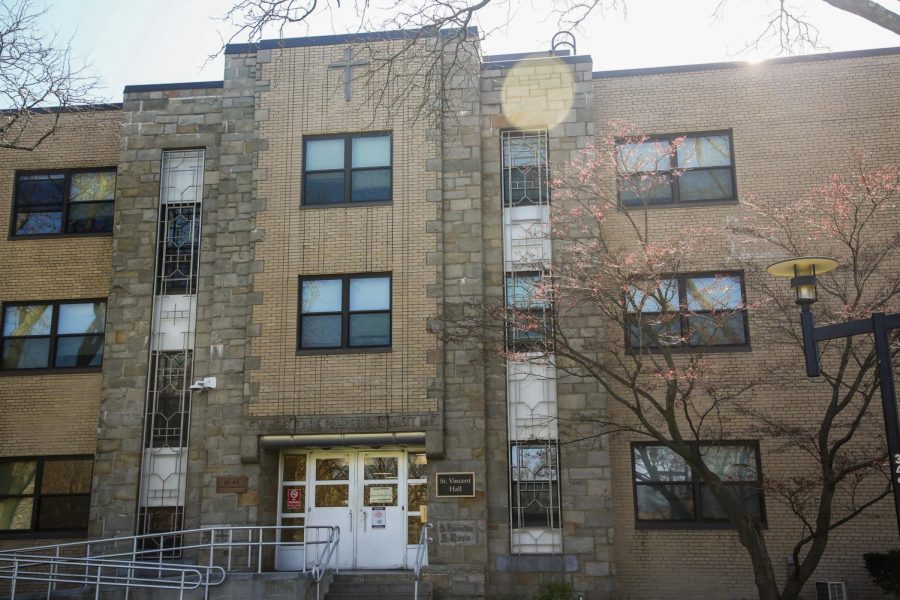St. Vincent’s Hall will no longer be a residence hall come fall, as construction for a new building in its place was announced in an Internal Communication recapping the events of the March Board of Trustee Meeting, on March 17. The site will be home to a new Health Sciences building on the Queens campus, set to be open to the public for classes by Fall of 2024, according to a St. John’s press release.
The building is estimated to cost $78 million by “a professional firm and construction manager.” A follow-up email on March 18 announced that the school had received a $5 million HECap grant, which will help to fund this new building.
“As the University has done in the past to finance capital projects, we will utilize a varied approach to secure the funds required to complete the project, including but not limited to government funding, private fundraising, corporate and foundation funds, grants, debt issuance, as well as other sources of capital project financing,” University President, Rev. Brian J. Shanley, O.P., told the Torch via email. “Multi-year fundraising campaigns have helped St. John’s to finance previous construction projects and will do so again.”
This building will be located where St. Vincent’s Hall currently stands, ending the building’s many years as a residence hall and making the Red Storm Diner obsolete. After determining the most cost-effective way to go through with this new project, Shanley says St. Vincent Hall was chosen as the new site being that “St. Vincent Hall is a 60-year-old building, and the existing campus footprint and infrastructure do not support the space needs required to achieve our planning and academic goals.”
Shanley assured those who reside in St. Vincent’s Hall, namely Catholic and Ozanam Scholars students, will not face housing troubles.
“The University does not anticipate a decrease in housing, and we will be able to accommodate resident students as we did this year when St. Vincent Hall was off-line and used as our COVID-19 isolation building,” he said. In regards to the Catholic Scholars, “this year while St. Vincent Hall was off-line as our COVID-19 isolation building, we utilized Donovan Hall since its room configuration most closely resembles that of St. Vincent Hall. We plan to continue that arrangement next year.”
Some students might question why the University is choosing to develop a new building during the pandemic, at a time where the University has been forced to make plenty of decisions that affect the student body — including the termination of housing options at the Staten Island campus.
“For 150 years, St. John’s has evolved and grown to meet the demands of the curriculum, and has done so in the best possible setting that our means allow,” Shanley said. “Efforts and decision-making undertaken by the University aim to ensure that we are providing students a vibrant educational experience with a variety of course offerings [that] are based on student needs. As students’ interests and enrollment trends change, we adjust and align programs to meet those needs.”
These new student interests include “existing and forthcoming health sciences programs,” as stated in the internal communication. According to the Bureau of Labor Statistics, careers in the health sciences industry are expected to grow 15% from 2019 to 2029. Shanley notes that “a number of the positions coming available in the health sciences field will require an associate degree or postsecondary non-degree to enter the profession. Those students who major in health science have broad opportunities within the workforce and, as such, a health science salary tends to be commensurate with one’s experience and education.”
Shanley says that St. John’s students can specifically look forward to several new undergraduate and graduate programs within the field.
“For example, a Master of Science in Health Sciences (M.S.H.S.) degree begins in the Fall of 2021,” he added. “The University anticipates approval from the New York State Education Department to offer a graduate program leading to a Doctor of Physical Therapy (DPT) degree. Interestingly, a nursing program was once part of St. John’s academic curriculum.”
The new Health Sciences Center is unique compared to other St. John’s science buildings such as St. Albert’s Hall and the Bartilucci Center because of its design, according to Shanley.
“Modern structural and mechanical systems allow for the reprogramming of the academic space within the building,” he said. “Teaching and office spaces can be easily reconfigured to meet changing curriculum, technology, and teaching methodologies.”
At this time, there are no plans to close other St. John’s science buildings, but campus buildings are constantly assessed to make sure they are being utilized to the fullest extent by students, so plans can change at any given time.
Shanley noted that he is very excited for construction on the building to begin. He also said he plans on keeping open lines of communication regarding the building’s progress over the estimated three-year development.
“The University has had considerable experience in simultaneously conducting day-to-day business operations while undertaking a construction project,” he said. “As with any large facilities project, there will be adjustments and some inconveniences, but the end result will be a state-of-the-art academic building that will transform the landscape and learning of the St. John’s community.”










